 The Latin Quarter of Paris is an area in the 5th and the 6th arrondissements of Paris situated on the Left Bank of the Seine. Known for student life, a lively atmosphere, and multiple bistros, the Latin Quarter is the home to a number of higher education establishments.
The Latin Quarter of Paris is an area in the 5th and the 6th arrondissements of Paris situated on the Left Bank of the Seine. Known for student life, a lively atmosphere, and multiple bistros, the Latin Quarter is the home to a number of higher education establishments.
 Sylvia Beach, an American, founded the first Shakespeare and Company in 1919 at 12 rue de l’Odéon. The shop was half bookstore and half
lending library, and it attracted the great expat writers of the
time—Hemingway, Fitzgerald, Eliot, Pound—and some of the century’s
most compelling female voices: Djuna Barnes, Gertrude Stein, Janet
Flanner, Kay Boyle, and Mina Loy. The bookstore was also frequented by celebrated French authors, such as André Gide, Paul Valéry, and Jules Romains.
Sylvia Beach, an American, founded the first Shakespeare and Company in 1919 at 12 rue de l’Odéon. The shop was half bookstore and half
lending library, and it attracted the great expat writers of the
time—Hemingway, Fitzgerald, Eliot, Pound—and some of the century’s
most compelling female voices: Djuna Barnes, Gertrude Stein, Janet
Flanner, Kay Boyle, and Mina Loy. The bookstore was also frequented by celebrated French authors, such as André Gide, Paul Valéry, and Jules Romains.
It served as the writers’ home away from home, postal address, and—when they were desperate—a loan service. Beach also helped usher in modern literature and published her friend James Joyce’s Ulysses in 1922 when no one else dared. French author André Chamson said that Beach “did more to link England, the United States, Ireland, and France than four great ambassadors combined.”
Beach’s bookstore was open until 1941, when the Germans occupied Paris. One day that December, a Nazi officer entered her store and demanded Beach’s last copy of Finnegans Wake. Beach declined to sell him the book. The officer said he would return in the afternoon to confiscate all of Beach’s goods and to close her bookstore. After he left, Beach immediately moved all the shop’s books and belongings to an upstairs apartment. In the end, she would spend six months in an internment camp in Vittel, and her bookshop would never reopen. Beach passed away in 1962 in Paris. (This was such a compelling story that I copied it from its website. Click here for the source)
American ex-serviceman George Whitman opened the bookstore in 1951 and named it after Sylvia Beach's bookstore in 1964. His daughter, Sylvia Beach Whitman and her partner, David Delannet, now run the store. She took over management of the store in 2011 after helping her father do it since 2003.

 Around the corner from Shakespeare and Company is Odette's with its specialty cream puffs that come in different flavors. They go well with a delicious cup of coffee. Our guide, Chantal, put us on to this amazing shop. Thanks!!
Around the corner from Shakespeare and Company is Odette's with its specialty cream puffs that come in different flavors. They go well with a delicious cup of coffee. Our guide, Chantal, put us on to this amazing shop. Thanks!!
Pantheon

The Panthéon
stands in the Latin Quarter. It was built by Louis XV between 1758 and
1790 as a church dedicated to Saint Genevieve,
Paris' patron saint. However, in 1791 during the French Revolution, the
National Constituent Assembly voted to transform it into a mausoleum
for the remains of distinguished French citizens. Included are Voltaire,
Victor Hugo, Rousseau, Émile Zola, Léon Gambetta, Jean Jaurès, Jean
Moulin, Antoine de Saint-Exupéry, Louis Braille, Pierre Curie, Alexandre
Dumas, Aimé Césaire, Simone Weil, and African-American Josephine Baker.
Click here
to see the ceremony for singer and dancer Josephine
Baker's induction into the Pantheon for her service as an Allied spy
during World War II.
The Sorbonne was founded in 1253, one of the first universities in the Western world. Later renamed University of Paris, it is still commonly known as "the Sorbonne".

 Mayor Anne Hidalgo is an environmentalist. One of her initiatives was to offer rental bicycles in order to reduce traffic and CO2 emissions. The light blue bikes are available all over the city She is a socialist who was elected in 2014 as the first woman mayor of Paris. She ran an unsuccessful campaign for president of France in 2022.
Mayor Anne Hidalgo is an environmentalist. One of her initiatives was to offer rental bicycles in order to reduce traffic and CO2 emissions. The light blue bikes are available all over the city She is a socialist who was elected in 2014 as the first woman mayor of Paris. She ran an unsuccessful campaign for president of France in 2022. "Midnight in Paris"
Woody Allen loves France and France loves Woody Allen. He has made several films here. One of the most famous is "Midnight in Paris", which is about a screenwriter who confronts his relationship with his materialistic fiancée and their divergent goals. These shortcomings become increasingly exaggerated as he travels back in time each night at midnight. The car that takes him to the past meets him at this Gothic/Renaissance styled church, Saint-Étienne-du-Mont.
The church contains the remains of St. Geneviève, patron saint of Paris. St. Geneviève converted King Clovis to Christianity in the 5th century. She also saved Paris from an attack by Attila the Hun and his army of 700,000.
"Emily in Paris"

The Netflix series, "Emily in Paris", takes place in this square, which includes her residence, the restaurant where her would-be boyfriend works, and the boulangerie. The plot is about a young woman from New York who comes to Paris to work in a marketing firm. While young American women are excited about the series, young French women are reviled by it because of its stereotypes and the arrogance of an American telling French professionals what to do. Click here to see their objections.

The Love Locks of Paris are padlocks that people buy, put their names on, and attach them to a particular place that they love. These locks are on the fences at Montmartre.
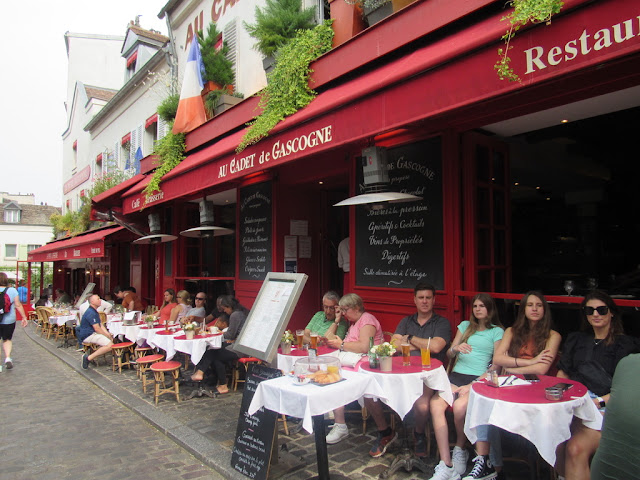




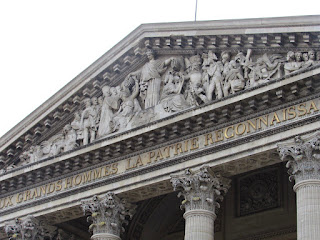

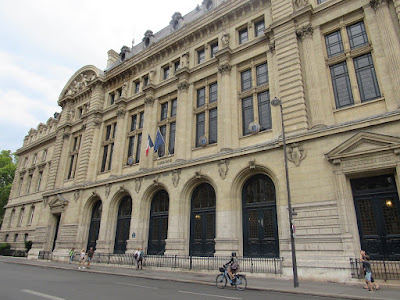




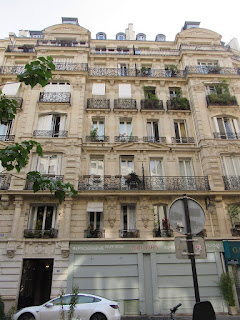
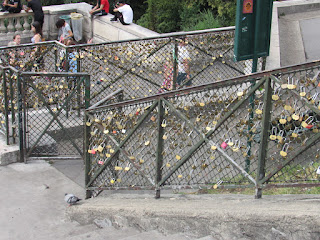
No comments:
Post a Comment